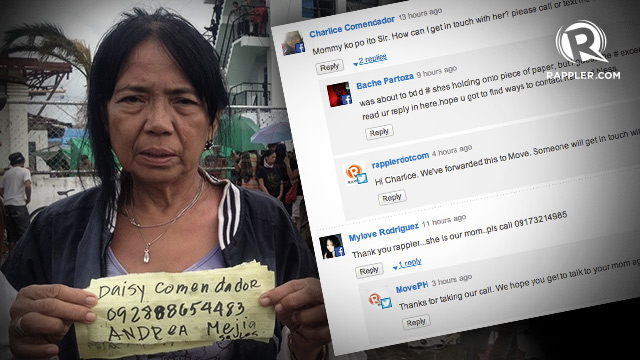SUMMARY
This is AI generated summarization, which may have errors. For context, always refer to the full article.

MANILA, Philippines – Daisy Comendador clung to the roof to survive a surge of sea water. Her daughter, Charlice Comendador, clung onto a thin thread of hope that her mother was alive.
“Four days kami na walang communication. Ang alam lang naming washed out `yong town,” said Charlice. (We didn’t have communication for four days. All we know is that the typhoon washed out our town.) While desperate, she never doubted that her mother was okay.
Life and death
Barangay San Jose, Tacloban, Leyte – where Daisy is from – was one of the hardest hit towns of Typhoon Yolanda (Haiyan). (READ: Yolanda and the world’s strongest storms) Five days after the typhoon, the Barangay is littered with debris and death.
Dead bodies wrapped in cloth, mats, and sacks are left along the road from the coastal village of San Jose to downtown Tacloban. When Rappler’s Voltaire Tupaz met Daisy, she made an appeal for the Department of Health to dispose of the cadavers.
Tupaz went to Tacloban to look for his family members and was shocked to discover the lack of any order on the streets. (READ: The stench of death in Tacloban)
Social media
Without any means of communication, Charlice and her relatives could only monitor the news for any proof that her mother was alive.
Charlice, however, said the more they watched the news, the stronger their fear grew.
“Ang nasa news, maraming patay. Pakiramdam naming hopeless case na na buhay ang mommy,” Charlice said. (The news was filled with reports of deaths. We thought my mom’s case was hopeless.)
The Comendador family did everything they could to trace their missing relative. They browsed every photo and video available on the web. They called radio and TV stations. They tried Google person finder.
“Napagod na kami kakaiyak. Sinusubukan naming magpatuloy ng buhay pero sinusubukan parin naming hanapin ang mommy,” Charlice shared. (We got tired from crying. We tried to go on with our lives but we still continued the search for my mother.)
Finally, on November 13, Charlice saw her mother’s photo on Rappler. Shortly after, Daisy messaged them, “buhay ako.” (I’m alive.)
According to Daisy, if she did not climb to the roof of their house, she probably would not have survived. Over the phone with Charlice, Daisy shared that the storm surge even reached their house’s second floor.
The Comendador family is planning to bring Daisy out of Tacloban to relieve her stress and worry. (Read: Survivors flee Tacloban nightmare)
Tracing missing relatives
For other friends and relatives of those affected by the typhoon, their search continues.
Various online lists have been created to collect information on the missing and those who have survived. Google’s Person Finder, has recorded 66,800 reports as of 3:00pm of November 13. (READ: #YolandaPH: Person finder)
Like Charlice, they are weathering all doubts and clinging onto hope that, amid the devastation brought by Typhoon Yolanda, their loved ones have found a way to survive the storm. – Rappler.com/with a report by Voltaire Tupaz
Add a comment
How does this make you feel?
There are no comments yet. Add your comment to start the conversation.